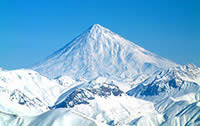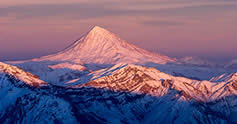Mount Damāvand

In Iranian Mythology

Damāvand is the scene of a number of Iranian mytho¬logical and legendary events. Gayōmard (NPers. Gayūmarṯ, Kayūmarṯ), the Zoroastrian prototype of human beings and the first king in the Šāh-nāma, was said to have resided in Damāvand. The foundation of the city of Damāvand was also attributed to him. Jamšēd was said to have traveled in the air from Damāvand to Bābel (Babylonia), riding in a majestic chariot made and driven by demons. According to a tradition preserved by Baḷʿamī, Jamšēd was attacked by Żaḥḥāk (q.v.) in Damāvand. This region also played an important role in the legends of Żaḥḥāk and Ferēdūn. Armāyel and Garmāyel, the two cooks of Bēvar-asb (Żaḥḥāk), were ordered by him to kill each day two young men in order to feed the two serpents growing from his shoulders. They evaded their duty, however, by killing only one and sending the other to Damāvand, thus saving a group of people, who resided there and constituted the ancestors of the Kurds. According to a tradition preserved by Ebn Esfandīār and repeated by Maṛʿašī, Ferēdūn was born in the village Var (or Varak) in the Lārījān area of Damāvand after his mother had sought refuge on Mount Damāvand. Finally Ferēdūn defeated Żaḥḥāk and sent him to Damāvand, where he was kept in chains at the bottom of a well; Ferēdūn appointed guards, who constantly beat on anvils with their heavy hammers in order to frighten the prisoner. Ferēdūn’s portrait was displayed on the rock face of the mountain in Żaḥḥāk’s view so that he dared not escape. The famous Ṭāqdīs throne of Ḵosrow II Parvēz (591-628 c.e.) is said to have been made originally by the ruler of Damāvand for Ferēdūn after he captured Żaḥḥāk.
 The tyrant was to remain imprisoned in Mount Damāvand until the end of the world, when he would release himself but would finally be killed by the Iranian hero Garšāsp. Garšāsp was said to be lying asleep in the plain Pēšānsē in Kābolestān, but, according to another tradition, which reflects a general tendency of the Zoroastrian divines of the Sasanian period to transpose eastern Iranian localities to the west, Pēšānsē was located in the vicinity of Mount Damāvand. In local popular belief the volcanic vapor that rises from the mountain is the breath of Żaḥḥāk, the flames his eyes, the dull sounds his groans, and the yellowish water flowing in the streams at the foot of the mountain his urine. A popular feast is reported to have been held in the city of Damāvand on 7 Šawwāl 1230/31 August 1815, during which the people celebrated the anniversary of Żaḥḥāk’s death.
The tyrant was to remain imprisoned in Mount Damāvand until the end of the world, when he would release himself but would finally be killed by the Iranian hero Garšāsp. Garšāsp was said to be lying asleep in the plain Pēšānsē in Kābolestān, but, according to another tradition, which reflects a general tendency of the Zoroastrian divines of the Sasanian period to transpose eastern Iranian localities to the west, Pēšānsē was located in the vicinity of Mount Damāvand. In local popular belief the volcanic vapor that rises from the mountain is the breath of Żaḥḥāk, the flames his eyes, the dull sounds his groans, and the yellowish water flowing in the streams at the foot of the mountain his urine. A popular feast is reported to have been held in the city of Damāvand on 7 Šawwāl 1230/31 August 1815, during which the people celebrated the anniversary of Żaḥḥāk’s death.
According to one tradition, the legendary king Manūčehr was born in Damāvand, and, according to another, Āraš shot his arrow from Mount Damāvand. The mountain was also the scene of an episode in the story of Rostam and Esfandīār, preserved in one of the epistles of the Armenian Grigor Magistros: Esfandīār tried to roll the mountain down on Rostam while he was sleeping, but Rostam woke up and kicked Esfandīār out by the tip of his boot; in a similar version in the Šāh-nāma it was Bahman, the son of Esfandīār, who tried to kill Rostam by rolling a rock down a mountain in Sīstān. According to popular belief the White Demon (Dīv-e sapīd), who was killed by Rostam, resided in Damāvand, and his daughter still lives there on an inaccessible rock, working with a spindle.

Mount Damāvand was believed by some Muslim authors to be the scene of the events in certain Semitic stories. Thus it was related that the demon Ṣaḵr was imprisoned there by Solomon. Hārūt and Mārūt were said to have been chained in this mountain. Damāvand has also often been referred to in Persian poetry. In this century Moḥammad-Taqī Malek-al-Šoʿaraʾ Bahār made Damāvand the subject of one of his best-known qaṣīdas.
